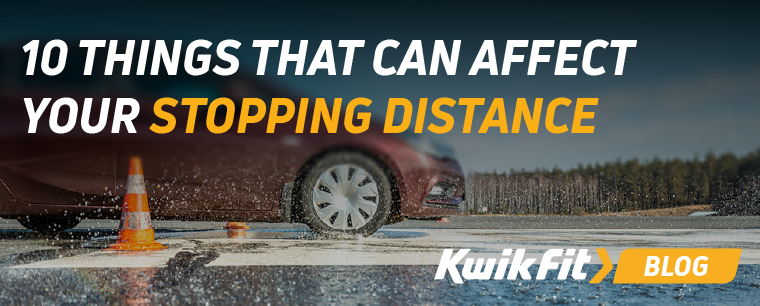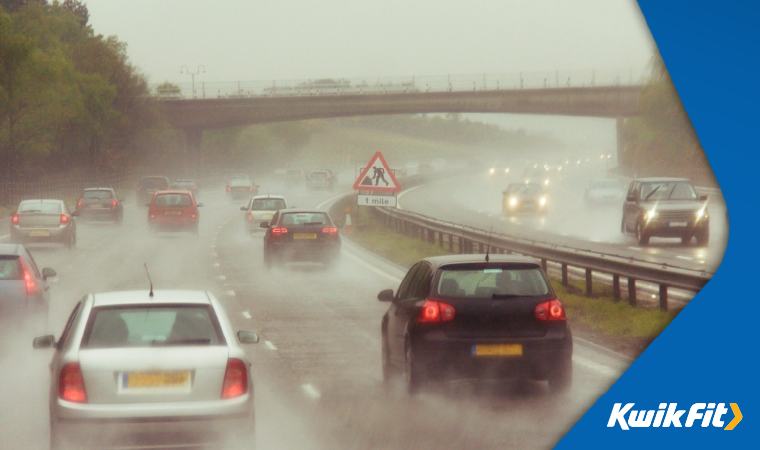10 things that can affect your stopping distance
Jessica Bird | Sunday 6th April 2025 12:02pm

When you need to hit the brakes, you want your car to stop in the shortest possible distance to avoid an accident. The distance that it takes for your car to come to a stop is crucial for your safety, particularly if you find yourself in a situation where you need to perform an emergency stop.
In this blog, weíll look at 10 factors that can affect how fast your car comes to a stop, what measures you can take to reduce your stopping distance, and what actions to avoid. Donít forget that if you believe your carís braking system isnít working how it should be, we can check it for you - and weíll do it for free.
What is your stopping distance?
Stopping distance is the time between the driver noticing and reacting to the need to stop (thinking distance) and the vehicle coming to a complete stop (braking distance). The driver needs to be alert and focused for optimum stopping distance, and the vehicleís braking components need to be in peak condition. When parts or systems degrade, itíll take longer to brake, making it more likely that an accident will occur.
Whenever youíre driving, itís essential to factor in the following:
1. Speed
Your speed is one of the only factors affecting your thinking and braking distance. Put simply, the faster you are going, the greater the distance travelled before you apply the brakes (thinking distance) and the vehicle comes to a complete stop (braking distance). This is before you consider factors such as slippery road conditions.
Between 20-40mph
When driving at moderate speeds between 20 and 40mph, your car can, on average, take 12 -36 metres to come to a complete stop. Within this range, you can typically expect a ďthree-carĒ measurement hike for every 10mph.
So, for example, if youíre driving at 30 miles per hour, your car will take around 23 metres (6 cars) to come to a complete stop, whilst at 40mph, it will take 36 metres to stop (9 cars). Thatís why observing the local speed limit and slowing down in residential areas is crucial.
Over 40mph
Driving at over 40mph? This number increases further, and a car travelling at 70mph on a motorway will take an average of 96 metres, or 24 car lengths, to come to a stop Ė so be sure to keep your distance from the car in front.
2. Brakes
Properly maintained brakes can make a big difference to your stopping distance. Brake pads have a block of friction material that pushes against the brake disc when the brakes are applied. This friction material wears down over time, and the brake disc can become grooved, causing it to overheat and lose stopping power. Therefore, well-maintained brakes will ultimately reduce your stopping distance.
Wet roads and standing water can also affect braking, causing moisture between the pads and discs, making them less effective at stopping your vehicle. If you have driven through deep water, pump the brake pedal a few times while driving slowly to dry the pads out and ensure they work when needed.
Book a free brake check at Kwik Fit.
3. Tyre Pressure
Tyres need the right amount of pressure to have optimal contact with the road, in order to brake effectively. Underinflated tyres will make more contact with the road on the outer edges of the tyre, which can reduce grip and traction.
Conversely, overinflated tyres will make more contact in the centre, impacting your handling due to the minimal contact. Checking your tyre pressure every month and using the recommended pressure in your vehicle handbook is an easy way to maintain your tyres, and ensure their ability to stop the vehicle.

4. Tyre Wear
Your tyres must be changed when the tread depth reaches 1.6mm by law. However, the tread depth can make a massive difference in your braking distance long before you reach this absolute minimum. Most tyres begin life with around 8mm of tread, which gradually wears away the more you use them (other factors, such as extreme braking, can also accelerate the wear rate).
As the tread reduces, so does the tyreís ability to grip the road. At 30mph on a wet road, a car with brand new tyres with 8mm of tread will come to a stop in 25.9 metres. The same car travelling in the same conditions, but fitted with tyres with just 3mm of tread remaining, would come to a stop at 35 metres. Thatís 35% further, despite the tyres still being perfectly legal. When the tyres reach the minimum of 1.6mm of tread, the stopping distance increases to 43 metres Ė thatís almost double the stopping distance of the new tyres!
Not sure if your tyres have legal tread depth? Take the 20p test.
5. Tyre Quality
Buying premium tyres from known manufacturers such as Michelin, Goodyear, or Pirelli provides peace of mind that you are buying a quality tyre product. Countless tyre tests show that premium tyres really are worth the extra cash when it comes to control, grip and stopping distance, and consistently outperform their budget counterparts.
When travelling at 60mph, a car fitted with premium tyres could stop as much as 16 metres shorter than a budget tyre, despite both sets of tyres having a full 8mm tread. Premium tyres have other proven benefits, including increased fuel efficiency, lifespan and aquaplaning resistance.

6. Road conditions
Whilst there are measures you can take to shorten your braking distance, like ensuring your tyres are in good shape, the weather is something that we unfortunately have no control over. Road conditions like standing water, ice and snow can greatly impact your stopping distance. Adding slippery surfaces reduces the friction between your tyres whilst on the road, affecting your braking distance.
In heavy rain aquaplaning can occur, where the tyres cannot quickly disperse the water between the tread and the road surface, leading to a loss of control. In wintery conditions, snow can become compacted in the tyre tread, significantly reducing the tyres' effectiveness and grip on the road. This can lead to sliding and stopping distances 10 times greater than on a dry road.
The best defence when driving in bad weather is to keep your distance, take it slow, and ensure you can maintain good awareness of your surroundings.
7. View of the Road
Visibility is one of factors that does not affect your braking distance per se, but can inhibit your thinking distance. The longer it takes to spot hazards on the road, the more time will have passed before you hit the brake pedal.
A dirty windscreen will reduce your view of the road, so top your windscreen wipers up with wiper fluid and keep everything clean. Damaged wiper blades can reduce your visibility even further by smearing dirt across your field of vision, so make sure you replace any damaged parts immediately.
Donít be tempted to set off on a cold, frosty morning before the windscreen has completely cleared. Get out there a few minutes early to warm the car up and scrape all the ice off to ensure you get to work safely and on time.
8. Distractions
Keeping your eyes on the road at all times will help you spot hazards and reduce your thinking time, but itís easy to become distracted - especially in this digital age of gadgets and in-car tech, which can flash and beep until we look at them. Common distractions whilst driving include:
- Mobile phones: Legally, you should never use your mobile phone while driving.
- Satnavs: Make sure you input your correct destination before setting off.
- Radio/music: As tempting as it is to change the station or song when itís not matching the mood, itís safer to leave it or ask a passenger to change it.
- Food and drinks: Whilst not illegal, itís important to not let it distract you whilst driving.
- Reaching for objects in the car: Pull over if you need to pick something up; itís not worth diverting your attention from the road.
- Looking at things inside and out of the car: Try not to stare at things that distract you from the road and any upcoming traffic.
- Other passengers: Chat away, but remain facing the road and donít let them distract you. Make sure any pets driving with you are appropriately harnessed.
9. Drink/Drug Driving
Alcohol and drugs, including cannabis, increase the time it takes to process information. A driver who is under the influence of drink or drugs could take a few extra vital seconds to spot a hazard, such as a pedestrian crossing the road, and apply the brakes. There is also evidence to suggest that a drunk/drug driver would not press the brake pedal as hard in an emergency stop situation because their senses are impaired.
It should go without saying that you shouldnít drink and drive Ė following decades of road awareness campaigns highlighting the dangers and consequences of drunk driving. After all, it can be fatal. More recently, there has been an increased focus on Ďdrug drivingí, as there has been a 40% increase from 2014 to 2022. Driving whilst under the influence of certain drugs can see drivers face penalties including a minimum 12-month driving ban, an unlimited fine and up to six months in prison.
10. Tiredness
As many as one-fifth of accidents on monotonous roads like motorways may be caused by drivers falling asleep at the wheel. But even if you donít drop off, driving while tired can severely slow your alertness and decision-making ability.
If you notice yourself getting tired or losing concentration while driving, make sure you find somewhere safe to stop and take a break. On long journeys, take a 15-minute break every two hours and share driving duties when possible. This will give you the best chance of staying alert and optimising your stopping distance.
Drive safely with Kwik Fit
Keep your vehicle in top condition with Kwik Fit. Contact us today or find your local Kwik Fit for advice from our experts, on everything from keeping your brakes in the best condition possible, to whether or not itís time to invest in some new tyres.
Keep updated with our blog to get the latest driving advice and news.
Any facts, figures and prices shown in our blog articles are correct at time of publication.
Featured Articles
Is it Illegal to Drive With One Headlight?
Saturday 19th July 2025
Wondering if itís illegal to drive with one headlight? Learn about the safety risks and penalties of illegal blown bulbs and why you should fix them promptly.
Air Con in EVs & Hybrids: Experts Answer Your Questions
Monday 30th June 2025
Does air con drain EV batteries? Can you use the air con while charging an electric car? Find out the answers to these questions & more from Kwik Fitís experts.
Why Is Your Car Making a Noise? Fixes & Tips
Friday 13th June 2025
When your car starts making unexpected noises, it can certainly be quite disconcerting; it may be nothing to worry about, but hereís what you need to know.









